The Improving Role of Basalt Fiber on the Sulfate–Chloride Multiple Induced Degradation of Cast-In-Situ Concrete
Abstract
1. Introduction
2. Materials and Methods
2.1. Materials
2.2. Specimen and Solution Preparation
2.3. Test Methods
2.3.1. Physical Properties
2.3.2. Mechanical Properties
2.3.3. Microstructural and Mineral Properties
3. Results and Discussion
3.1. Microstructural and Mineral Properties
3.1.1. Mineral Properties
3.1.2. Microstructures
3.2. Physical Properties
3.2.1. Appearance Change
3.2.2. Size and Mass Changes
3.3. Mechanical Properties
3.3.1. Flexural Strength
3.3.2. Compressive Strength
3.4. Sulfate Concentration
4. Conclusions
- Premixed chloride has a significant detrimental influence on the strength development of cast-in-situ concrete. Concrete powder spalling occurs on the surface of the specimen under the ICA.
- Although chloride is in competition with sulfate, the most severe corrosion of the specimens occurs under the ESA-ICA combined attack. Large areas of concrete powder spalling occur on the surface of the specimen, and the strength development of the specimen is severely affected.
- Increasing fiber content is beneficial for enhancing its effectiveness when the fiber content is less than 0.5%. After premixing with BF, the physical and mechanical properties of cast-in-situ concrete are improved. BF mainly plays the role of reinforcement and improvement. In terms of strengthening, BF filled the original defects of the specimen and improved the bearing capacity of the strength specimen. In terms of crack resistance, it limits the development of cracks and reduces stress concentration at the crack tip.
- The filling and bridging effects of basalt fibers alleviate the negative effects of internal and external corrosion. When the basalt fiber content is 0.5%, the flexural strength of the specimen is increased by 16.2%. Results show that BF can reduce the internal pores of concrete and improve the corrosion resistance of concrete. Therefore, it is feasible to premix BF into cast-in-situ concrete to improve the corrosion resistance and mechanical properties of concrete.
Author Contributions
Funding
Institutional Review Board Statement
Informed Consent Statement
Data Availability Statement
Acknowledgments
Conflicts of Interest
References
- Kosior-Kazberuk, M. Post-cracking Behaviour and Fracture Energy of Synthetic Fiber Reinforced Concrete. Mater. Sci. 2016, 22, 542–547. [Google Scholar]
- Cai, R.; Qi, H.; Mao, J. Improved crack resistance and pore structure of cement-based materials by adding EVA powder. J. Mater. Civ. Eng. 2022, 34, 04022012. [Google Scholar] [CrossRef]
- Ma, W.; Qin, Y.; Li, Y. Mechanical properties and engineering application of cellulose fiber-reinforced concrete. Mater. Today Commun. 2020, 22, 100818. [Google Scholar] [CrossRef]
- Porras, Y.; Jones, C.; Schmiedeke, N. Freezing and thawing durability of high early strength portland cement concrete. J. Mater. Civ. Eng. 2020, 32, 04020077. [Google Scholar] [CrossRef]
- Bruyn, K.D.; Bescher, E.; Ramseyer, C. Pore structure of calcium sulfoaluminate paste and durability of concrete in freeze–thaw environment. Int. J. Concr. Struct. Mater. 2017, 11, 59–68. [Google Scholar] [CrossRef]
- Aghaeipour, A.; Madhkhan, M. Mechanical properties and durability of roller compacted concrete pavement (RCCP)—A review. Road. Mater. Pavement. Des. 2020, 21, 1775–1798. [Google Scholar] [CrossRef]
- Haufe, J.; Vollpracht, A. Tensile strength of concrete exposed to sulfate attack. Cem. Concr. Res. 2019, 116, 81–88. [Google Scholar] [CrossRef]
- Tan, L.; Wang, F.; Liang, M. Antibiotic resistance genes attenuated with salt accumulation in saline soil. J. Hazard. Mater. 2019, 374, 35–42. [Google Scholar] [CrossRef]
- Wang, X.; Xue, Z.; Lu, X. Salt leaching of heavy coastal saline silty soil by controlling the soil matric potential. Soil Water Res. 2019, 14, 132–137. [Google Scholar] [CrossRef]
- He, R.; Zheng, S.; Gan, V.J.L. Damage mechanism and interfacial transition zone characteristics of concrete under sulfate erosion and Dry-Wet cycles. Constr. Build. Mater. 2020, 255, 119340. [Google Scholar] [CrossRef]
- Wee, T.H.; Suryavanshi, A.K.; Wong, S.F. Sulfate resistance of concrete containing mineral admixtures. Mater. J. 2000, 97, 536–549. [Google Scholar]
- Zhao, G.; Li, J.; Han, F. Sulfate-induced degradation of cast-in-situ concrete influenced by magnesium. Constr. Build. Mater. 2019, 199, 194–206. [Google Scholar] [CrossRef]
- Yu, X.; Chen, D.; Feng, J. Behavior of mortar exposed to different exposure conditions of sulfate attack. Ocean Eng. 2018, 157, 1–12. [Google Scholar] [CrossRef]
- Scherer, C.; Lima, L.F.; Zorzi, J.E. Effect of partial replacement of cement by fine powders on the corrosion resistance of concrete. Constr. Build. Mater. 2023, 401, 132982. [Google Scholar] [CrossRef]
- Mermerdaş, K.; Güneyisi, E. Effect of different types of calcined crude kaolins and high purity metakaolin on corrosion resistance of reinforcement in concretes: Experimental evaluation and analytical modeling. Constr. Build. Mater. 2023, 382, 131288. [Google Scholar] [CrossRef]
- Peng, L.; Zhao, Y.; Ban, J. Enhancing the corrosion resistance of recycled aggregate concrete by incorporating waste glass powder. Cem. Concr. Compos. 2023, 137, 104909. [Google Scholar] [CrossRef]
- Dong, Q.; Zhang, Y.; Feng, L. Experimental research of sulfate corrosion resistance of fresh concrete with fly ash. Adv. Mater. Res. 2013, 772, 109–116. [Google Scholar] [CrossRef]
- Canpolat, F. Sulfate resistance of mortars containing silica fume and pozzolan. Proc. Inst. Civ. Eng.-Constr. Mater. 2012, 165, 65–72. [Google Scholar] [CrossRef]
- Yan, X.; Jiang, L.; Guo, M. Evaluation of sulfate resistance of slag contained concrete under steam curing. Constr. Build. Mater. 2019, 195, 231–237. [Google Scholar] [CrossRef]
- Sumer, M. Compressive strength and sulfate resistance properties of concretes containing Class F and Class C fly ashes. Constr. Build. Mater. 2012, 34, 531–536. [Google Scholar] [CrossRef]
- Yang, J.; Wang, P.; Li, H. Sulfate attack resistance of air-entrained silica fume concrete under dry-wet cycle condition. J. Wuhan Univ. Technol.-Mater. Sci. Ed. 2016, 31, 857–864. [Google Scholar] [CrossRef]
- Petková, M.; Ujhelyiová, A.; Ryba, J. Sorption Capabilities of Polypropylene/Modified Polypropylene Fibers. Fibers 2023, 11, 102. [Google Scholar] [CrossRef]
- Golewski, G.L. Enhancement fracture behavior of sustainable cementitious composites using synergy between fly ash (FA) and nanosilica (NS) in the assessment based on digital image processing procedure. Theor. Appl. Fract. Mech. 2024, 131, 104442. [Google Scholar] [CrossRef]
- Zhang, P.; Zheng, Y.; Wang, K. Combined influence of nano-CaCO3 and polyvinyl alcohol fibers on fresh and mechanical performance of concrete incorporating fly ash. Struct. Concr. 2020, 21, 724–734. [Google Scholar] [CrossRef]
- Jiang, X.; Lu, D.; Yin, B. Advancing carbon nanomaterials-engineered self-sensing cement composites for structuralhealth monitoring: A state-of-the-art review. J. Build. Eng. 2024, 87, 109129. [Google Scholar] [CrossRef]
- Fan, H.H.; Wang, C.; Hu, Y.; Zhao, G. Durability Performance of Basalt Fiber-Reinforced Concrete Subjected to Sul-fate–Magnesium Combined Attack. Materials 2024, 17, 1128. [Google Scholar] [CrossRef]
- Yoo, D.Y.; Banthia, N. Impact resistance of fiber-reinforced concrete—A review. Cem. Concr. Compos. 2019, 104, 103389. [Google Scholar] [CrossRef]
- Bright Singh, S.; Madasamy, M. Investigation of aggregate size effects on properties of basalt and carbon fibre-reinforced pervious concrete. Road Mater. Pavement Des. 2022, 23, 1305–1328. [Google Scholar] [CrossRef]
- John, V.J.; Dharmar, B. Influence of basalt fibers on the mechanical behavior of concrete—A review. Struct. Concr. 2021, 22, 491–502. [Google Scholar] [CrossRef]
- Jiang, X.; Zhang, F.; Huang, B. Full-scale accelerated testing of geogrid-reinforced inverted pavements. Geotext. Geomembr. 2024, 52, 511–525. [Google Scholar] [CrossRef]
- Chao, Z.; Fowmes, G.; Mousa, A. A new large-scale shear apparatus for testing geosynthetics-soil interfaces in-corporating thermal condition. Geotext. Geomembr. 2024, 52, 999–1010. [Google Scholar] [CrossRef]
- Sohail, M.G.; Alnahhal, W.; Taha, A. Sustainable alternative aggregates: Characterization and influence on mechanical behavior of basalt fiber reinforced concrete. Constr. Build. Mater. 2020, 255, 119365. [Google Scholar] [CrossRef]
- Zeng, Y.; Zhou, X.; Tang, A. Mechanical properties of chopped basalt fiber-reinforced lightweight aggregate concrete and chopped polyacrylonitrile fiber reinforced lightweight aggregate concrete. Materials 2020, 13, 1715. [Google Scholar] [CrossRef]
- Zhou, H.; Jia, B.; Huang, H. Experimental study on basic mechanical properties of basalt fiber reinforced concrete. Materials 2020, 13, 1362. [Google Scholar] [CrossRef] [PubMed]
- Chen, X.; Kou, S.; Xing, F. Mechanical and durable properties of chopped basalt fiber reinforced recycled aggregate concrete and the mathematical modeling. Constr. Build. Mater. 2021, 298, 123901. [Google Scholar] [CrossRef]
- Zhao, Y.R.; Wang, L.; Lei, Z.K. Experimental study on dynamic mechanical properties of the basalt fiber reinforced concrete after the freeze-thaw based on the digital image correlation method. Constr. Build. Mater. 2017, 147, 194–202. [Google Scholar] [CrossRef]
- Zhao, Y.R.; Wang, L.; Lei, Z.K. Study on bending damage and failure of basalt fiber reinforced concrete under freeze-thaw cycles. Constr. Build. Mater. 2018, 163, 460–470. [Google Scholar] [CrossRef]
- Algi, Z.; Ozen, M. The properties of chopped basalt fiber reinforced self-compacting concrete. Constr. Build. Mater. 2018, 186, 678–685. [Google Scholar] [CrossRef]
- Niu, D.; Huang, D.; Fu, Q. Experimental investigation on compressive strength and chloride permeability of fiber-reinforced concrete with basalt-polypropylene fibers. Adv. Struct. Eng. 2019, 22, 2278–2288. [Google Scholar] [CrossRef]
- Dong, Y.; Jaillon, L.; Chu, P. Comparing carbon emissions of precast and cast-in-situ construction methods–A case study of high-rise private building. Constr. Build. Mater. 2015, 99, 39–53. [Google Scholar] [CrossRef]
- Jiang, X.; Zhu, H.; Yan, Z.; Zhang, F.; Huang, X.; Leng, Z.; Yan, C.; Hua, N.; Lu, D.; Zhang, X.; et al. Fire-retarding asphalt pavement for urban road tunnels: A state-of-the-art review and beyond. Fire Technol. 2024, 1–41. [Google Scholar] [CrossRef]
- Chao, Z.; Li, Z.; Dong, Y.; Shi, D.; Zheng, J. Estimating compressive strength of coral sand aggregate concrete in marine environment by combining physical experiments and machine learning-based techniques. Ocean Eng. 2024, 308, 118320. [Google Scholar] [CrossRef]
- Dobrovolski, M.E.G.; Munhoz, G.S.; Pereira, E. Effect of crystalline admixture and polypropylene microfiber on the internal sulfate attack in Portland cement composites due to pyrite oxidation. Constr. Build. Mater. 2021, 308, 125018. [Google Scholar] [CrossRef]
- Gu, Y.; Dangla, P.; Martin, R.P. Modeling the sulfate attack induced expansion of cementitious materials based on interface-controlled crystal growth mechanisms. Cem. Concr. Res. 2022, 152, 106676. [Google Scholar] [CrossRef]
- Wilson, W.; Gonthier, J.N.; Georget, F. Insights on chemical and physical chloride binding in blended cement pastes. Cem. Concr. Res. 2022, 156, 106747. [Google Scholar] [CrossRef]
- Gu, Y.; Metalssi, O.O.; Martin, R.P. Locating ettringite due to DEF at the pore scale of cement paste by heat-based dissolution tests. Constr. Build. Mater. 2020, 258, 120000. [Google Scholar] [CrossRef]
- Cherif, R.; Hamami, A.E.A.; Aït-Mokhtar, A. Thermodynamic equilibria-based modelling of reactive chloride transport in blended cementitious materials. Cem. Concr. Res. 2022, 156, 106770. [Google Scholar] [CrossRef]
- Li, L.L.; Chai, H.; Hu, Y.; He, R.; Wang, Z. Feasibility study on superabsorbent polymer (SAP) as internal curing agent for cement-based grouting material. Constr. Build. Mater. 2024, 411, 134286. [Google Scholar] [CrossRef]
- Jiang, L.; Niu, D. Study of deterioration of concrete exposed to different types of sulfate solutions under drying-wetting cycles. Constr. Build. Mater. 2016, 117, 88–98. [Google Scholar] [CrossRef]
- Hwang, W.; Ann, K.Y. Determination of rust formation to cracking at the steel–concrete interface by corrosion of steel in concrete. Constr. Build. Mater. 2023, 367, 130215. [Google Scholar] [CrossRef]
- Wang, X.; Liu, J.; Jin, Z. Real-time strain monitoring of reinforced concrete under the attacks of sulphate and chloride ions based on XCT and DIC methods. Cem. Concr. Compos. 2022, 125, 104314. [Google Scholar] [CrossRef]
- Sotiriadis, K.; Nikolopoulou, E.; Tsivilis, S. Sulfate resistance of limestone cement concrete exposed to combined chloride and sulfate environment at low temperature. Cem. Concr. Compos. 2012, 34, 903–910. [Google Scholar] [CrossRef]
- Zhang, C.; Chen, W.; Mu, S. Numerical investigation of external sulfate attack and its effect on chloride binding and diffusion in concrete. Constr. Build. Mater. 2021, 285, 122806. [Google Scholar] [CrossRef]
- Abdalkader, A.; Lynsdale, C.; Cripps, J. Corrosion behaviour of steel rebar in mortars subjected to magnesium sulfate and sodium chloride mixtures at 5 and 20 °C. Constr. Build. Mater. 2017, 153, 358–363. [Google Scholar] [CrossRef]
- Xu, W.J.; Li, Z.R. Service life prediction of basalt fiber reinforced concrete under salt freeze-thaw cycles. Stavební Obz.-Civ. Eng. J. 2022, 31, 222–234. [Google Scholar] [CrossRef]
- Wang, Z.S.; LI, Y.K.; Lu, J.L.; Tian, J.B.; Zhao, K. Research on Corrosion Characteristics and Performance Degradation of Basalt Fiber Concrete under Sodium Magnesium Sulfate Corrosion Environment. J. Coast. Res. 2020, 111, 56–62. [Google Scholar] [CrossRef]
- Mercuri, M.; Vailati, M.; Gregori, A. Lime-based mortar reinforced with randomly oriented polyvinyl-alcohol (PVA) fibers for strengthening historical masonry structures. Dev. Built Environ. 2023, 14, 100152. [Google Scholar] [CrossRef]
- Lv, Z.; Tan, H.; Liu, X. Chloride binding of AFm in the presence of Na+, Ca2+ and Ba2+. Constr. Build. Mater. 2023, 364, 129804. [Google Scholar] [CrossRef]
- Geng, J.; Easterbrook, D.; Li, L. The stability of bound chlorides in cement paste with sulfate attack. Cem. Concr. Res. 2015, 68, 211–222. [Google Scholar] [CrossRef]
- Jin, Z.; Zhao, X.; Zhao, T. Effect of mineral admixture and fibers on shrinkage crack of sacrificial concrete. J. Adv. Concr. Technol. 2016, 14, 502–510. [Google Scholar] [CrossRef][Green Version]
- Saradar, A.; Tahmouresi, B.; Mohseni, E. Restrained shrinkage cracking of fiber-reinforced high-strength concrete. Fibers 2018, 6, 12. [Google Scholar] [CrossRef]
- Ikumi, T.; Cavalaro, S.H.P.; Segura, I. Alternative methodology to consider damage and expansions in external sulfate attack modeling. Cem. Concr. Res. 2014, 63, 105–116. [Google Scholar] [CrossRef]
- Campos, A.; López, C.M.; Aguado, A. Diffusion–reaction model for the internal sulfate attack in concrete. Constr. Build. Mater. 2016, 102, 531–540. [Google Scholar] [CrossRef]
- Hime, W.G.; Mather, B. Sulfate attack. Cem. Concr. Res. 1999, 29, 789–791. [Google Scholar] [CrossRef]
- Antolik, A.; Jóźwiak-Niedźwiedzka, D. ASR induced by chloride-and format-based deicers in concrete with non-reactive aggregates. Constr. Build. Mater. 2023, 400, 132811. [Google Scholar] [CrossRef]
- Wang, X.; Ni, W.; Jin, R. Formation of Friedel’s salt using steel slag and potash mine brine water. Constr. Build. Mater. 2019, 220, 119–127. [Google Scholar] [CrossRef]
- Rui, A.; Wang, L.; Lin, W. Experimental study on damage anisotropy of 3D-printed concrete exposed to sulfate attack. Constr. Build. Mater. 2023, 407, 133590. [Google Scholar] [CrossRef]
- Li, J.; Yang, L.; Xie, H. Research on impact toughness and crack propagation of basalt fiber reinforced concrete under SHPB splitting test. J. Build. Eng. 2023, 77, 107445. [Google Scholar] [CrossRef]
- Guo, Y.; Pan, H.; Shen, A. Fracture properties of basalt-fiber-reinforced bridge concrete under dynamic fatigue loading. Structures 2023, 56, 105018. [Google Scholar] [CrossRef]

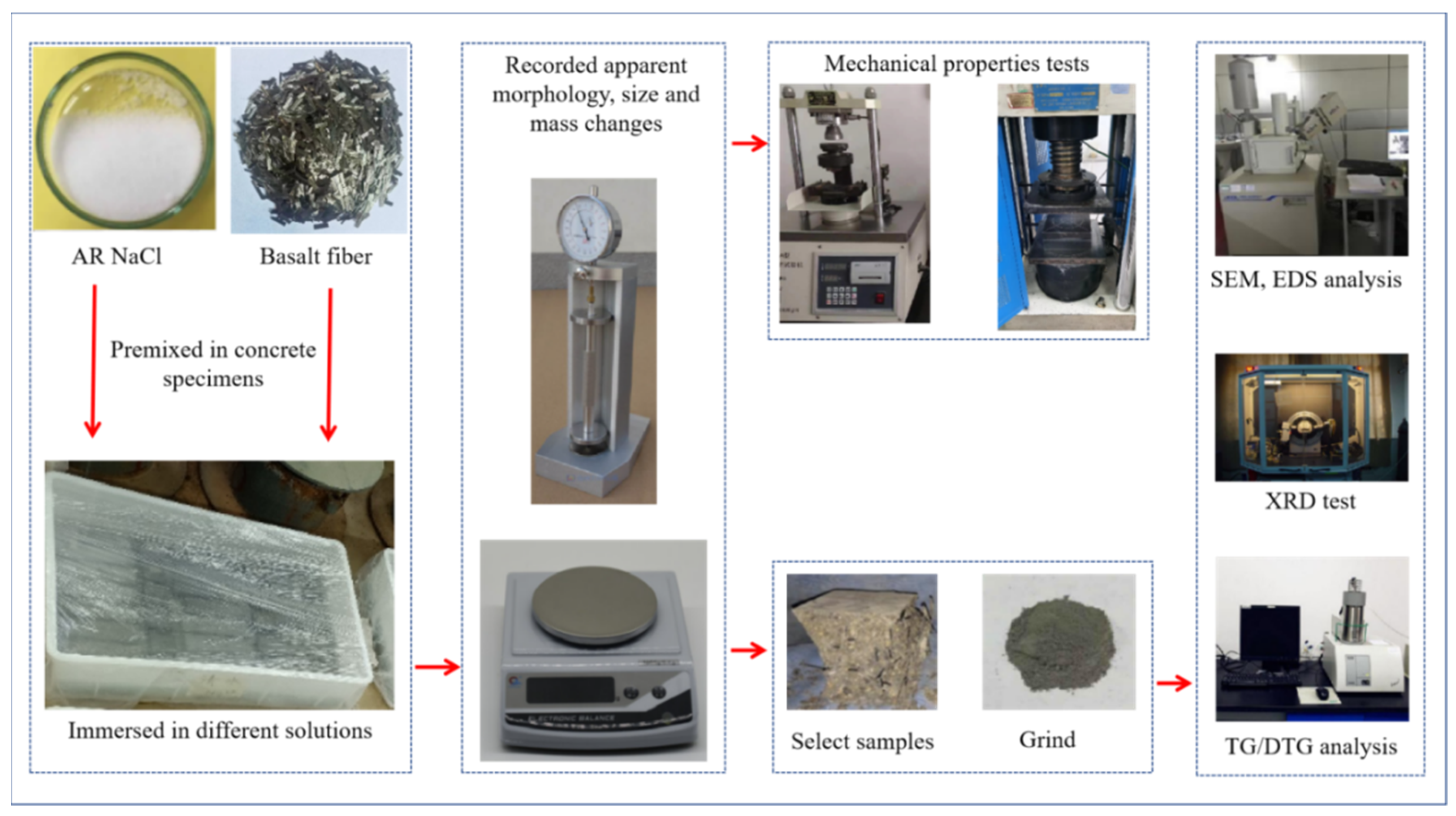
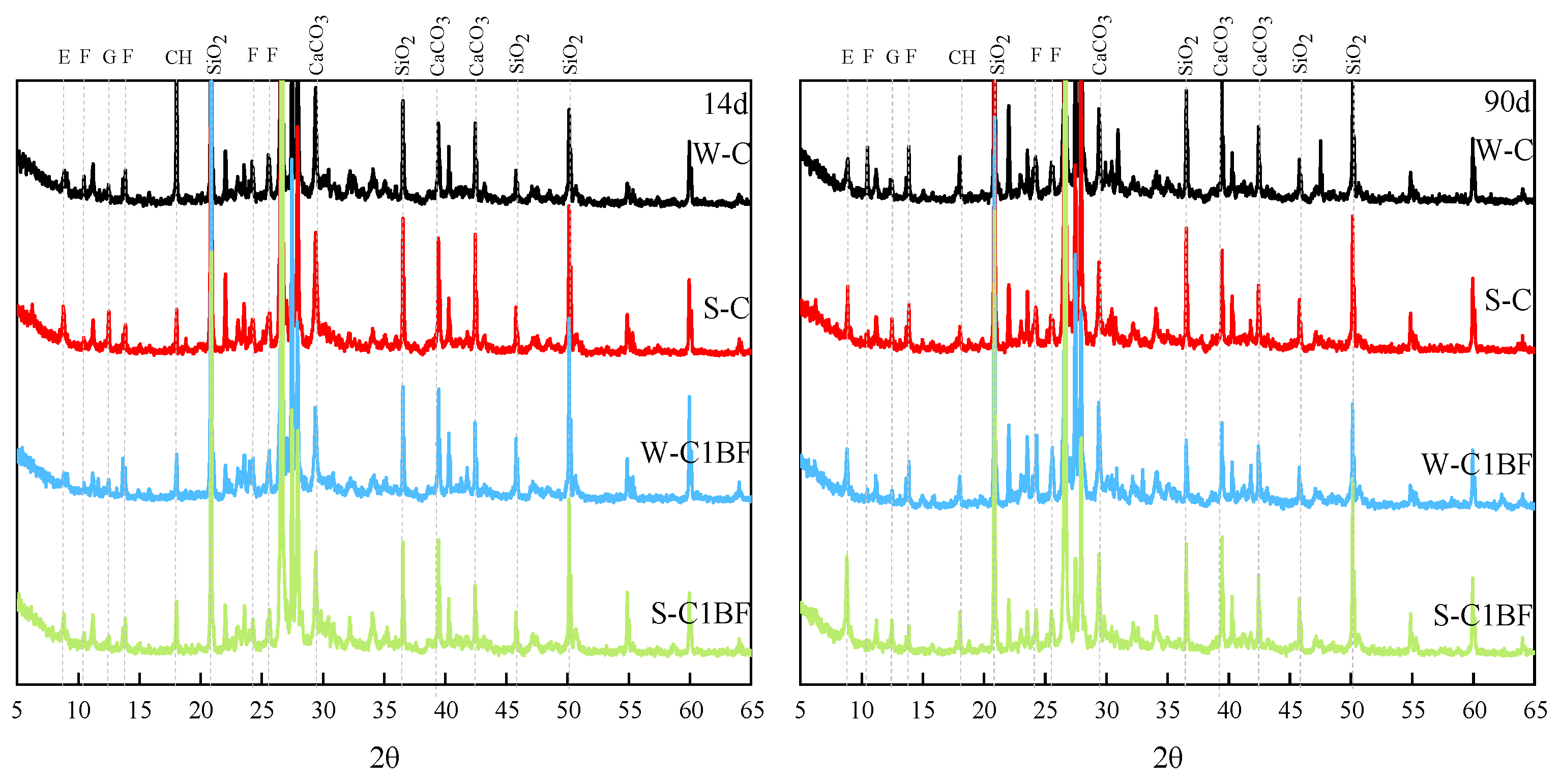
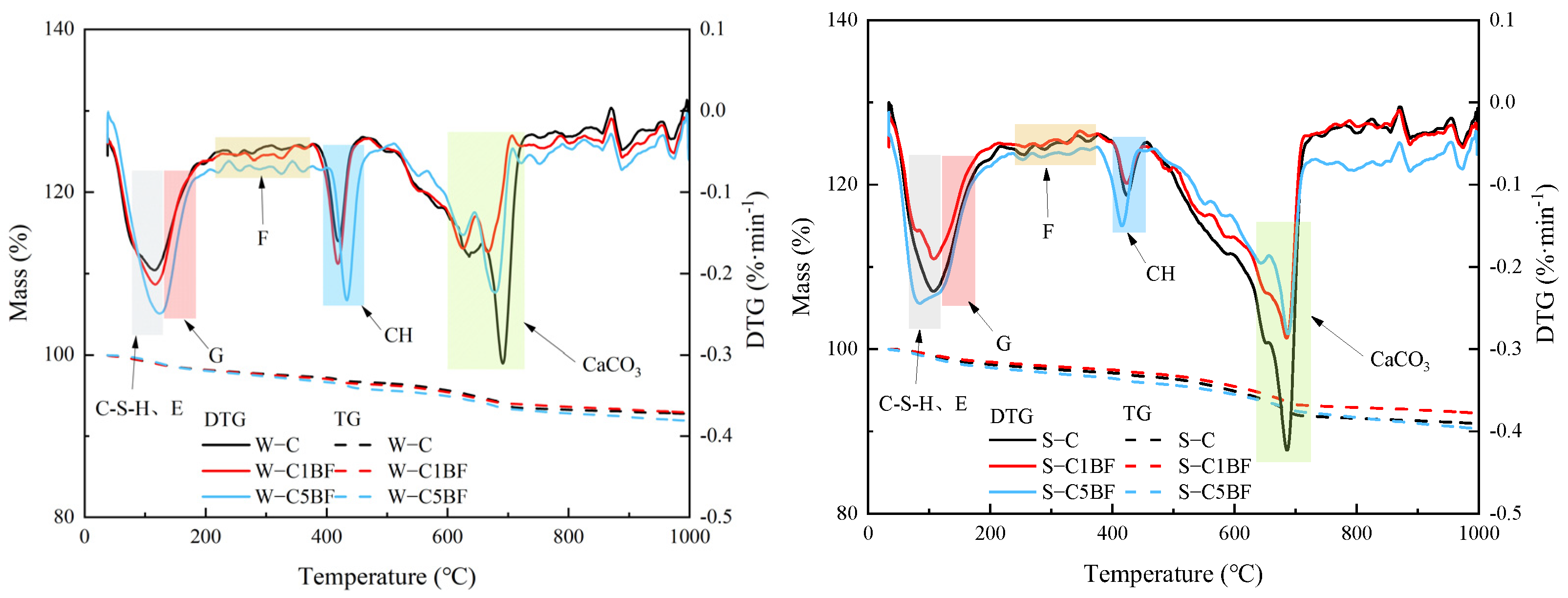
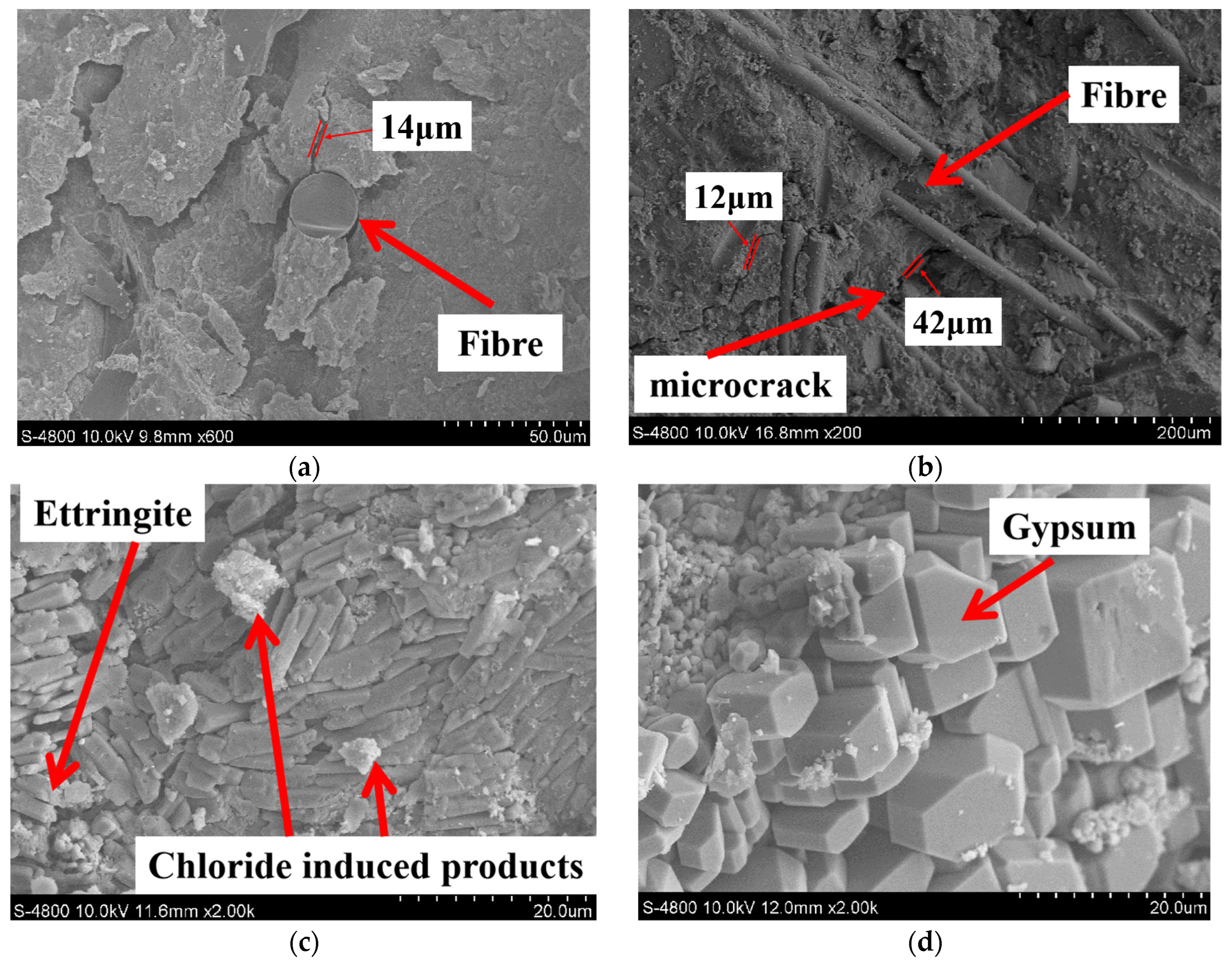
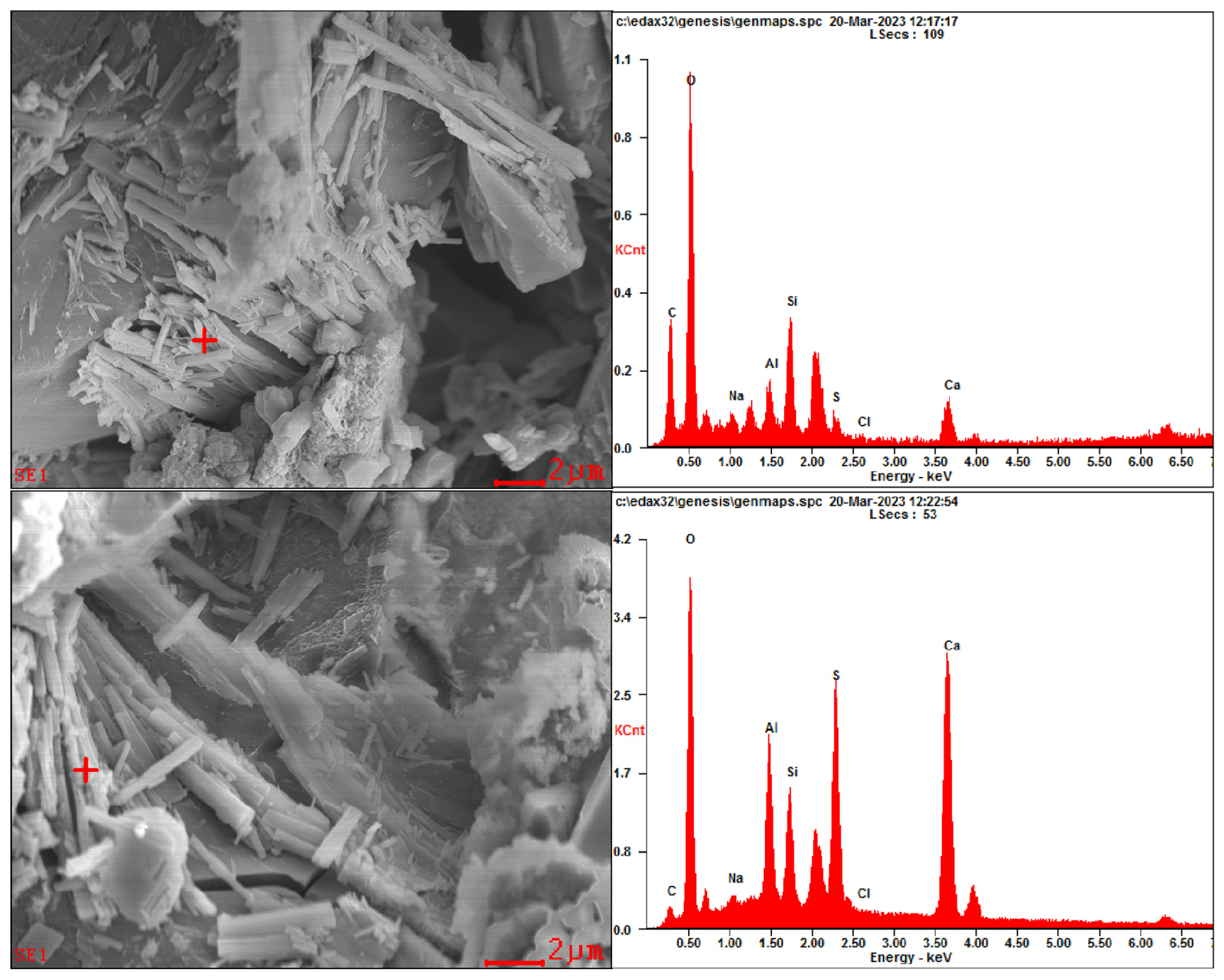

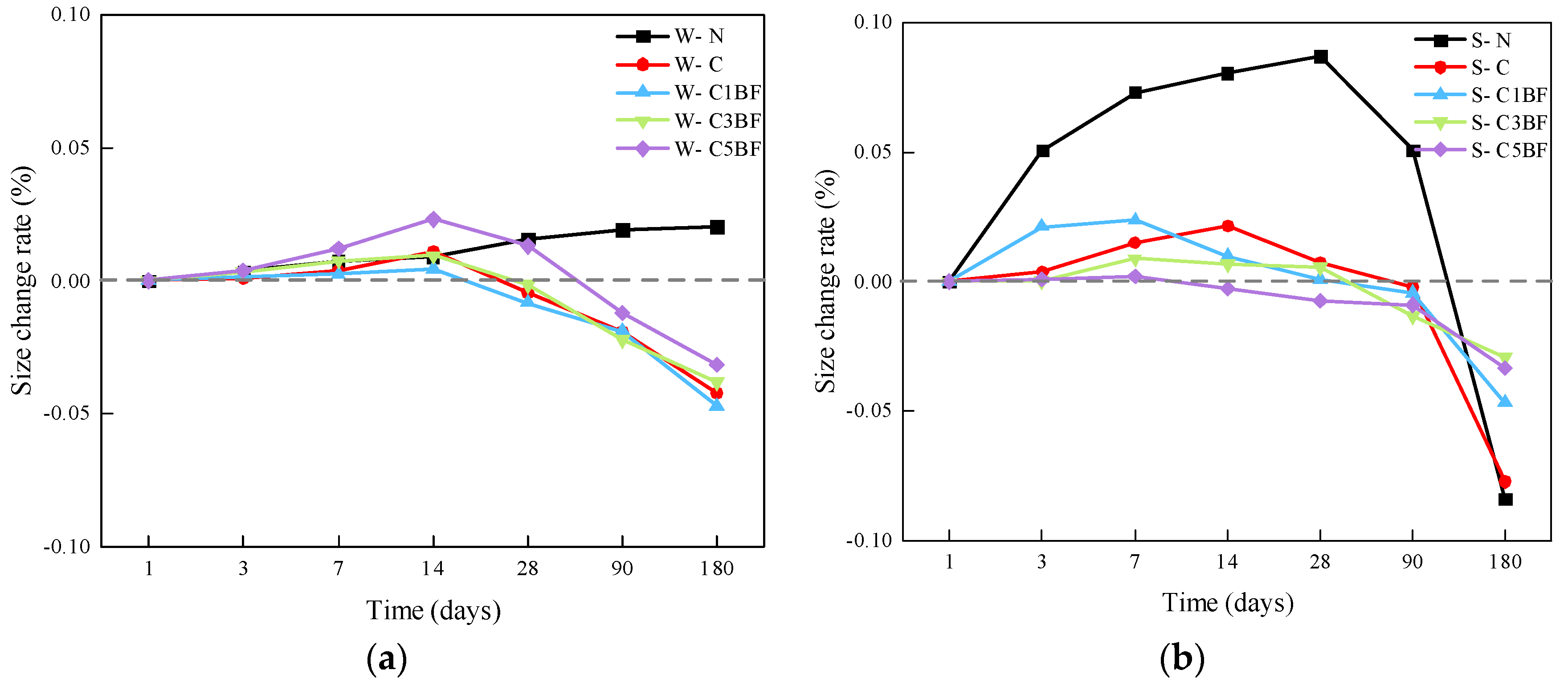

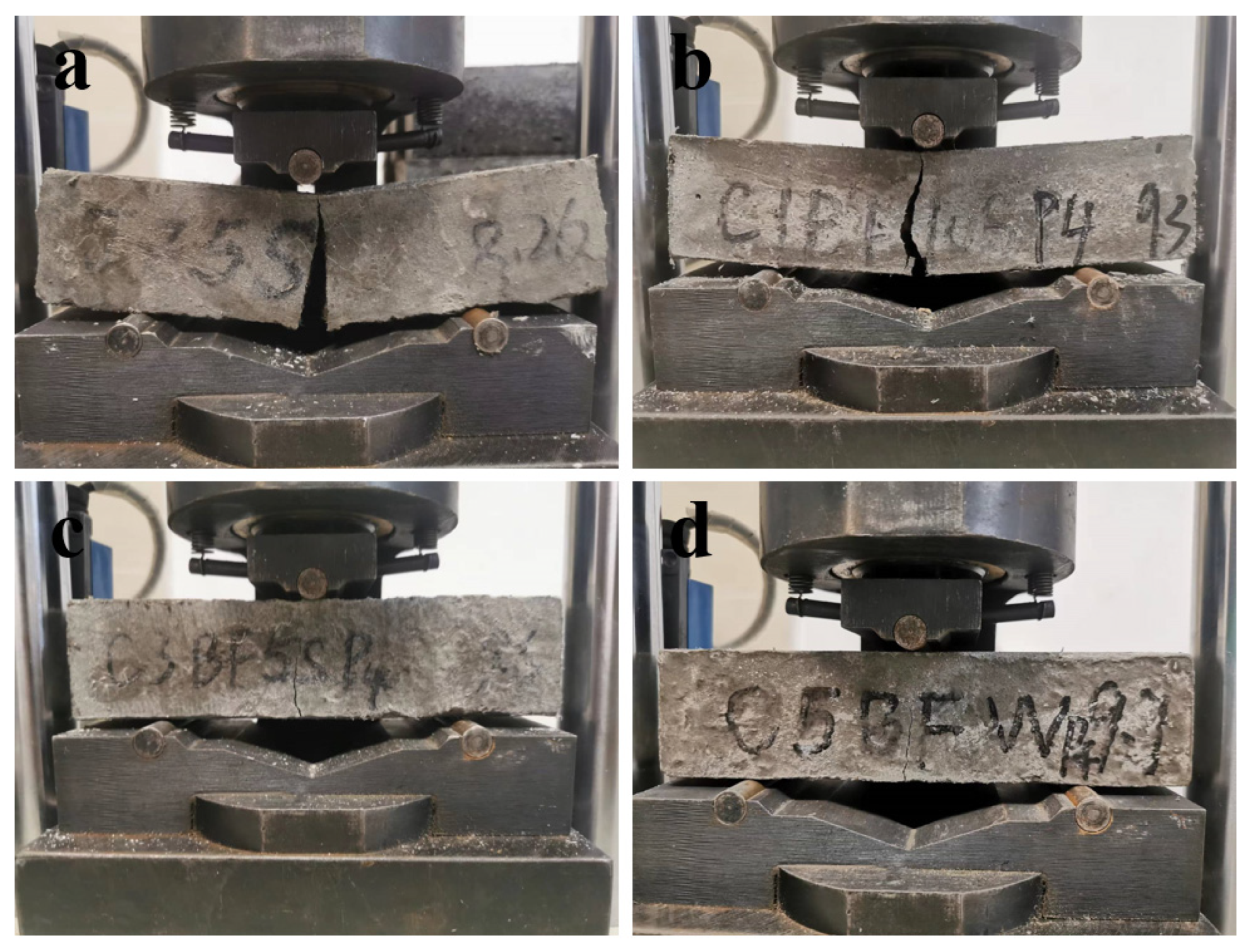
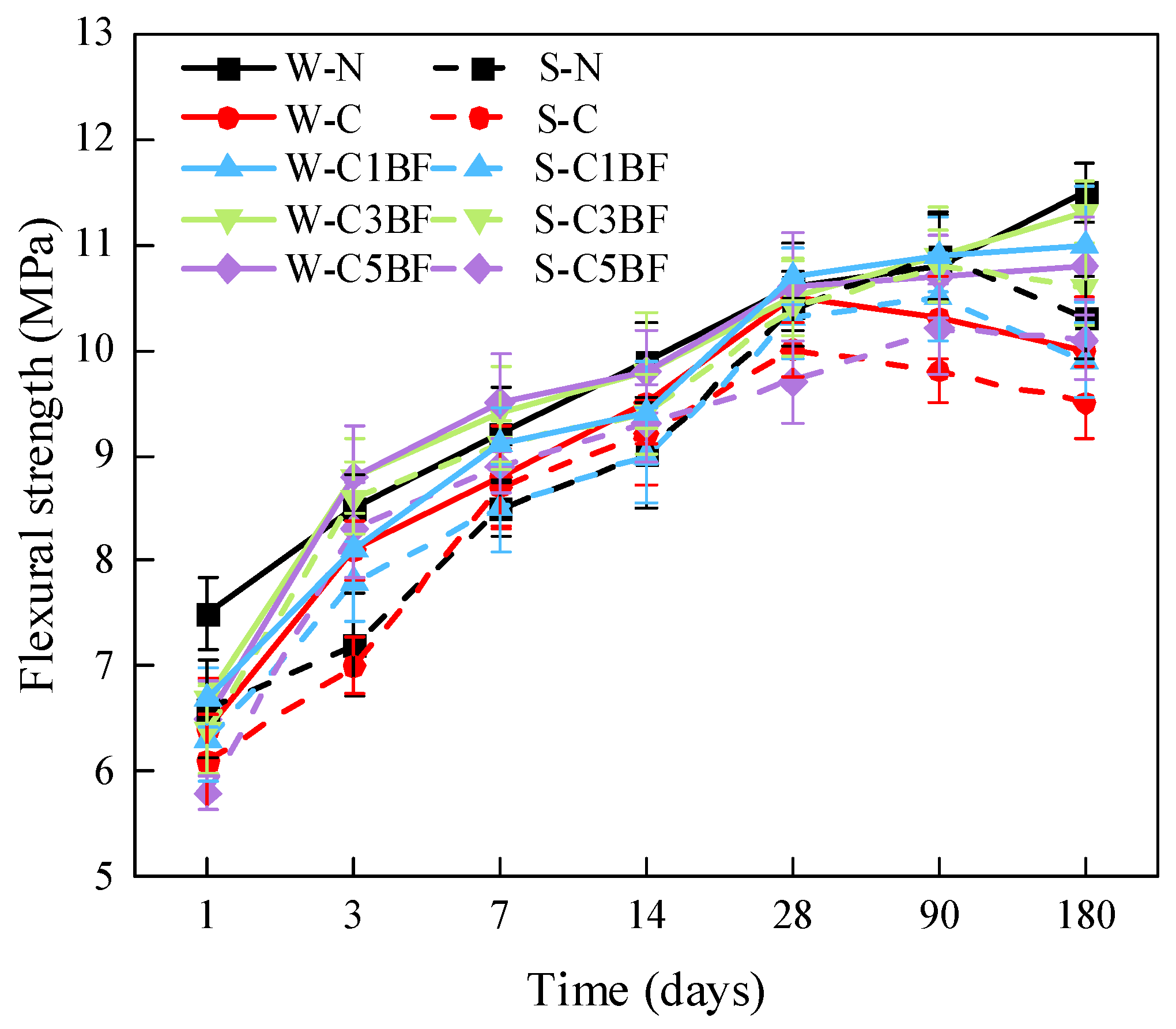
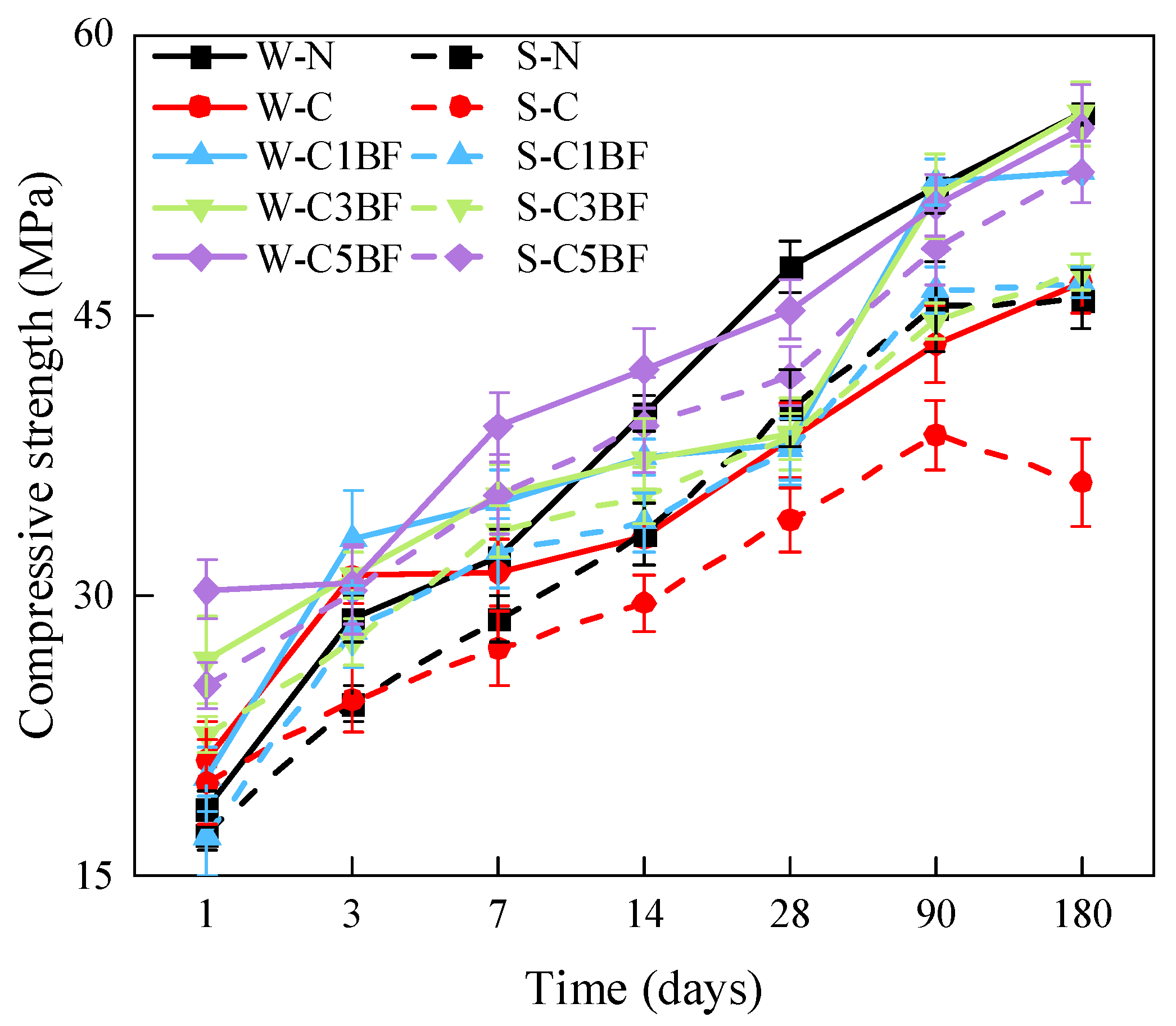
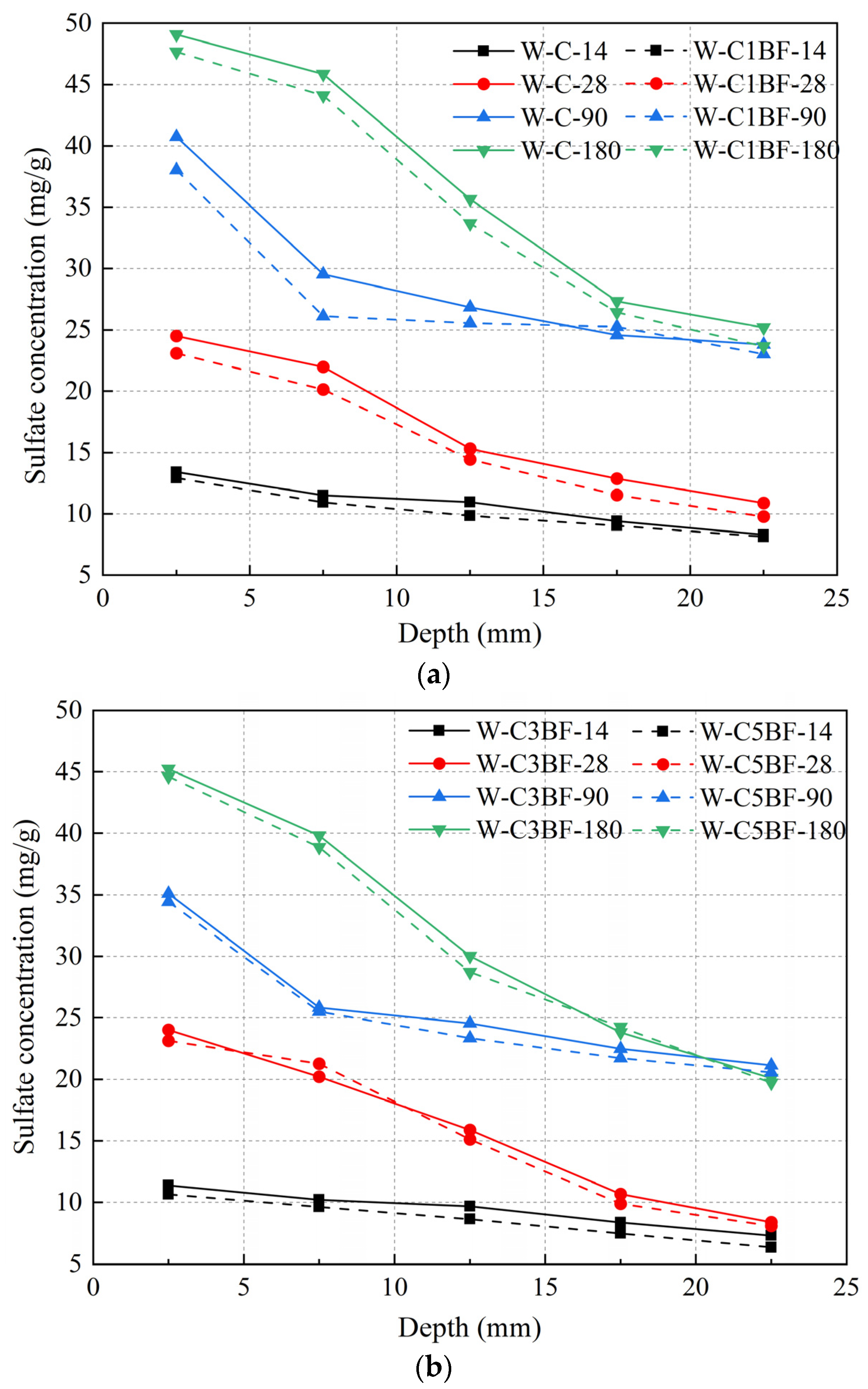
| Chemical Composition | Al2O3 | SiO2 | SO3 | Cl | TiO2 | Fe2O3 | Na2O | K2O | MgO | CaO |
|---|---|---|---|---|---|---|---|---|---|---|
| Content (%) | 5.64 | 18.48 | 2.40 | 0.08 | 0.51 | 3.63 | 0.31 | 0.68 | 0.75 | 67.21 |
| Material | Length (mm) | Diameter (μm) | Tensile Strength (MPa) | Elastic Modulus (GPa) | Density (g/cm3) |
|---|---|---|---|---|---|
| Basalt fiber | 12 | 17 | 3000–4800 | 90–100 | 2.80 |
| W/C | Cement (kg/m3) | Water (kg/m3) | Sand (kg/m3) | Pebble (kg/m3) |
|---|---|---|---|---|
| 0.46 | 478 | 220 | 629 | 983 |
| Specimens in Distilled Water | Specimens Soaked in Na2SO4 Solution | Mixed Salt | Mixed BF | Number of Samples | Slump (cm) |
|---|---|---|---|---|---|
| W-N | S-N | No | No | 42 | 6.8 |
| W-C | S-C | 3% Cl− | No | 42 | 8.2 |
| W-C1BF | S-C1BF | 3% Cl− | 0.1%BF | 42 | 7.4 |
| W-C3BF | S-C3BF | 3% Cl− | 0.3%BF | 42 | 4.6 |
| W-C5BF | S-C5BF | 3% Cl− | 0.5%BF | 42 | 2.2 |
Disclaimer/Publisher’s Note: The statements, opinions and data contained in all publications are solely those of the individual author(s) and contributor(s) and not of MDPI and/or the editor(s). MDPI and/or the editor(s) disclaim responsibility for any injury to people or property resulting from any ideas, methods, instructions or products referred to in the content. |
© 2024 by the authors. Licensee MDPI, Basel, Switzerland. This article is an open access article distributed under the terms and conditions of the Creative Commons Attribution (CC BY) license (https://creativecommons.org/licenses/by/4.0/).
Share and Cite
Hu, Y.; Wang, Z.; Chen, Z.; Wang, C.; Ding, S.; Nie, Z.; Hou, T.; Zhao, G. The Improving Role of Basalt Fiber on the Sulfate–Chloride Multiple Induced Degradation of Cast-In-Situ Concrete. Materials 2024, 17, 4454. https://doi.org/10.3390/ma17184454
Hu Y, Wang Z, Chen Z, Wang C, Ding S, Nie Z, Hou T, Zhao G. The Improving Role of Basalt Fiber on the Sulfate–Chloride Multiple Induced Degradation of Cast-In-Situ Concrete. Materials. 2024; 17(18):4454. https://doi.org/10.3390/ma17184454
Chicago/Turabian StyleHu, Yiqi, Zhuo Wang, Zhilong Chen, Cheng Wang, Shijun Ding, Zhibao Nie, Tianxin Hou, and Gaowen Zhao. 2024. "The Improving Role of Basalt Fiber on the Sulfate–Chloride Multiple Induced Degradation of Cast-In-Situ Concrete" Materials 17, no. 18: 4454. https://doi.org/10.3390/ma17184454
APA StyleHu, Y., Wang, Z., Chen, Z., Wang, C., Ding, S., Nie, Z., Hou, T., & Zhao, G. (2024). The Improving Role of Basalt Fiber on the Sulfate–Chloride Multiple Induced Degradation of Cast-In-Situ Concrete. Materials, 17(18), 4454. https://doi.org/10.3390/ma17184454






